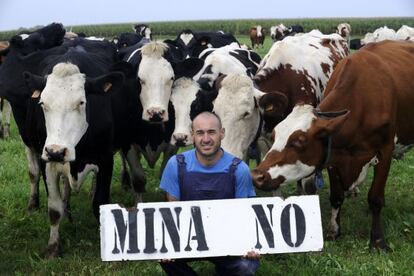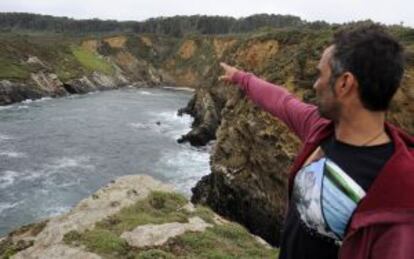Golden opportunity divides town in rural Asturias
Regional government to decide whether to authorize Canadian mining project in November


The dispute dates back four years. Some locals still refuse to use certain shops in the village because their owner has taken one side or another regarding a proposal by Canadian company Asturgold to mine one of Europe’s last major gold reserves – an estimated two million ounces – which lies underground near the small rural community of Tapia de Casariego, in Asturias, on Spain’s Cantabrian coast.
Tapia de Casariego’s 4,000 or so residents, most of whom work in fishing, farming, or tourism – although a good number are among Spain’s more than four-and-a-half million unemployed – must now decide whether to allow the company to dig out the gold and create around 200 jobs over the next eight years.
For some, the mine is a solution to the community’s problems, and will help slow the numbers of young people leaving in search of work elsewhere. For others, it will destroy a sustainable way of life in a unique rural environment.
The gold is located about 300 meters inland from the area’s rocky coastline in an area known as Salave. To avoid digging an open cast mine, Asturgold is proposing to excavate a 2.7-kilometer access tunnel in an area of woodland and pasture that forms part of the Camino de Santiago pilgrimage route.
The mining company is trying to take advantage of people’s desperation” Jesús, cattle breeder
Jesús, a local farmer who breeds a special variety of cattle whose milk is used to make baby food, making it subject to strict health controls, fears he may lose his contract if the mine goes ahead. Similarly, local fishermen say that waste from the mine could end up in the sea, destroying their livelihood. “The mining company is trying to take advantage of people’s desperation, and they have divided the community,” says Jesús.
An estimated 200,000 tonnes of waste would be produced to get at the gold, which Asturgold says would first be sifted to remove any toxic material such as sulfur and arsenic, and then stored in a 10-hectare site. José Valdés, the chief engineer of the project, says that any water running off into the sea would be clean enough to drink, and insists that Asturgold has addressed all environmental issues and has “nothing to hide”.
But the regional water authority, the Confederación Hidrográfica del Cantábrico, disagrees, and has recommended ditching the project three times, the last on September 12. It says that local rivers and the sea will not be able to absorb the waste from the proposed site. However, the Confederación has no legal authority in the matter. Local fishermen who make a living from harvesting gooseneck barnacles – which filter sea water – say that even if waste dumped into the sea is not toxic, it would cloud water and kill marine life.

Asturgold owner Cary Pinkowski bought the local company Explotaciones Mineras del Cantábrico in 2009, using it as a vehicle to buy a mining license for Salave. Opponents of the proposed mine say they fear that once the company has all the necessary paperwork required to go ahead with the project, it will sell the company, and that its promises to protect the environment will not be worth the paper they were written on. They cite previous cases where this has happened.
Opponents also say that promises of jobs for up to eight years or longer are also dependent on gold prices, which have fluctuated wildly over the last decade, rising from $300 an ounce in 2002, to a high of $1,900 an ounce in 2011; they now stand at around $960 an ounce. Asturgold admits that if prices were to fall sharply it would have to close the mine.
The problem is that the Romans got here first, and for 300 years hacked out the easiest-to-get-at seams. The gold that is left is deep underground and encrusted in a mineral called granodiorite, which also contains sulfur and arsenic. Extracting the gold involves oxidizing the rock using cyanide, which the company says it will do outside Spain. Before that, the rock will be treated with biodegradable chemicals, a process that only allows for a concentrate of 200 grams per tonne, which is less cost effective.
We’re not fools. We know we can’t trust the firm 100 percent. But if it obeys the law, it should be allowed to mine” Local resident Magdalena Gómez
Just 700 meters from the proposed mine entrance, where this process would be taking place, is a school for mentally disabled children that has an organic farm covering nine hectares that produces around 25,000 kilograms of vegetables a year. The school says it would have to close the farm if the gold mine goes ahead.
The key issue here is employment, or the lack of it. Asturgold says it has received around 12,000 job applications. Magdalena Gómez, an unemployed laboratory assistant, is in favor of the project, and runs an association called Trabajo sí, mina ya (Work yes, mine now). She admits she sees no alternative, and admits that the issue has divided the community: there are bars where she is no longer welcome, and others like her have had their car tires slashed. Her husband is among the few who have already been taken on. “We’re not fools, we know that we cannot trust the company 100 percent. But if it obeys the law, it should be allowed to mine. I am hoping that the local authorities make the right decision, but that they take their time.”
Regional environment chief Belén Fernández says a decision will be made by mid-November. Tapia’s previous mayor, who is opposed to the project, says the Canadian ambassador has intervened in support of the mine; his successor supports the project, arguing that it will bring jobs.
The mining company says that if the regional government decides against the project, it will take the matter to court and demand compensation. If it goes ahead, the half of the community opposed to the mine will also bring legal action. In other words, Tapia will never be the same again.
Tu suscripción se está usando en otro dispositivo
¿Quieres añadir otro usuario a tu suscripción?
Si continúas leyendo en este dispositivo, no se podrá leer en el otro.
FlechaTu suscripción se está usando en otro dispositivo y solo puedes acceder a EL PAÍS desde un dispositivo a la vez.
Si quieres compartir tu cuenta, cambia tu suscripción a la modalidad Premium, así podrás añadir otro usuario. Cada uno accederá con su propia cuenta de email, lo que os permitirá personalizar vuestra experiencia en EL PAÍS.
¿Tienes una suscripción de empresa? Accede aquí para contratar más cuentas.
En el caso de no saber quién está usando tu cuenta, te recomendamos cambiar tu contraseña aquí.
Si decides continuar compartiendo tu cuenta, este mensaje se mostrará en tu dispositivo y en el de la otra persona que está usando tu cuenta de forma indefinida, afectando a tu experiencia de lectura. Puedes consultar aquí los términos y condiciones de la suscripción digital.
Archived In
Últimas noticias
Most viewed
- Alain Aspect, Nobel laureate in physics: ‘Einstein was so smart that he would have had to recognize quantum entanglement’
- Alvin Hellerstein, a 92-year-old judge appointed by Bill Clinton, to preside over Maduro’s trial in New York
- Gilles Lipovetsky: ‘If you want to live better and fall in love, take Prozac, don’t look to philosophy’
- Cuba confirms death of 32 of its citizens in the US attack against Venezuela
- Why oil has been at the center of Venezuela-US conflicts for decades








































